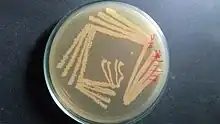Kytococcus sedentarius
Kytococcus sedentarius is a marine dwelling Gram positive bacterium in the genus Kytococcus.[1][2] It is known for the production of polyketide antibiotics as well as for its role as an opportunistic pathogen. It is strictly aerobic and can only grow when amino acids are provided.
| Kytococcus sedentarius | |
|---|---|
 | |
| Kytococcus sedentarius culture on Zobell's Marine Agar (Himedia) plate (quadrant streak plate). | |
| Scientific classification | |
| Domain: | Bacteria |
| Phylum: | Actinomycetota |
| Class: | Actinomycetia |
| Order: | Micrococcales |
| Family: | Kytococcaceae |
| Genus: | Kytococcus |
| Species: | K. sedentarius |
| Binomial name | |
| Kytococcus sedentarius | |
| Type strain | |
| ATCC 14392[3] CCM 314 CCUG 33030 CIP 81.72 DSM 20547 IFO 15357 JCM 11482 LMG 14228 NBRC 15357 NCTC 11040 VKM B-1316 | |
| Synonyms | |
| |
It is found in tetrads, irregular clusters, and cubical packets of eight. It is catalase positive, oxidase positive, and exhibits strictly aerobic metabolism. Optimum growth temperature is 25-37 C. It is primarily isolated from human skin, and is one of the major causes of pitted keratolysis.[4][5] Once considered a species of the genus Micrococcus.[6]
Genome
The genome has been sequenced and contains 2,785,024 bp,[7] which is among the smallest for Actinomycetes, with a G+C content of 71.6%. This encodes 2639 protein coding genes.
References
- Zobell CE, Upham HC. (1944). "A list of marine bacteria including descriptions of sixty new species". Bulletin Scripps Institution of Oceanography University of California (Technical Series). 5: 239–292.
- Stackebrandt E, Koch C, Gvozdiak O, Schumann P (1995). "Taxonomic dissection of the genus Micrococcus: Kocuria gen. nov., Nesterenkonia gen. nov., Kytococcus gen. nov., Dermacoccus gen. nov., and Micrococcus Cohn 1872 gen. emend". Int J Syst Bacteriol. 45 (4): 682–692. doi:10.1099/00207713-45-4-682. PMID 7547287.
- Parte, A.C. "Kytococcus". LPSN.
- Longshaw, C. M.; Wright, J. D.; Farrell, A. M.; Holland, K. T. (2002). "Kytococcus sedentarius, the organism associated with pitted keratolysis, produces two keratin-degrading enzymes". Journal of Applied Microbiology. 93 (5): 810–816. doi:10.1046/j.1365-2672.2002.01742.x. ISSN 1364-5072. PMID 12392527.
- Makhecha, Meena; Dass, Shreya; Singh, Tishya; Gandhi, Riddhi; Yadav, Tulika; Rathod, Dipali (November 2017). "Pitted keratolysis—a study of various clinical manifestations". International Journal of Dermatology. 56 (11): 1154–1160. doi:10.1111/ijd.13744. ISSN 1365-4632. PMID 28924971. S2CID 23775733.
- "Kytococcus sedentarius". www.vumicro.com. Retrieved 2016-07-08.
- Sims, David; Brettin, Thomas; Detter, John C.; Han, Cliff; Lapidus, Alla; Copeland, Alex; Del Rio, Tijana Glavina; Nolan, Matt; Chen, Feng; Lucas, Susan; Tice, Hope; Cheng, Jan-Fang; Bruce, David; Goodwin, Lynne; Pitluck, Sam; Ovchin-Nikova, Galina; Pati, Amrita; Ivanova, Natalia; Mavrommatis, Konstantinos; Chen, Amy; Palaniappan, Krishna; d'Haeseleer, Patrik; Chain, Patrick; Bristow, Jim; Eisen, Jonathan A.; Markowitz, Victor; Hugenholtz, Philip; Schneider, Susanne; Göker, Markus; et al. (2009). "Complete genome sequence of Kytococcus sedentarius type strain (541)". Stand Genomic Sci. 1 (1): 12–20. doi:10.4056/sigs.761. PMC 3035214. PMID 21304632.
Further reading
- Gao, Min; Wang, Ke; Su, Rongguo; Li, Xuzhao; Lu, Wei (Jul 2014). "Antifouling potential of bacteria isolated from a marine biofilm". Journal of Ocean University of China. 13 (5): 799–804. Bibcode:2014JOUC...13..799G. doi:10.1007/s11802-014-2469-9. S2CID 88398988.
External links